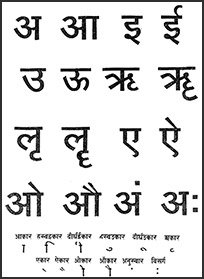Namadhatu, Nāmadhātu, Naman-dhatu: 7 definitions
Introduction:
Namadhatu means something in Hinduism, Sanskrit, Marathi. If you want to know the exact meaning, history, etymology or English translation of this term then check out the descriptions on this page. Add your comment or reference to a book if you want to contribute to this summary article.
In Hinduism
Vyakarana (Sanskrit grammar)
Source: Wikisource: A dictionary of Sanskrit grammarNāmadhātu (नामधातु).—A denominative root; the term सुब्धातु (subdhātu) is also used for नामधातु (nāmadhātu); cf. सुब्धातुर्नामधातुरभिधीयते (subdhāturnāmadhāturabhidhīyate) Nyāsa on P. VI. 1.3. See the word धातु (dhātu).

Vyakarana (व्याकरण, vyākaraṇa) refers to Sanskrit grammar and represents one of the six additional sciences (vedanga) to be studied along with the Vedas. Vyakarana concerns itself with the rules of Sanskrit grammar and linguistic analysis in order to establish the correct context of words and sentences.
Languages of India and abroad
Marathi-English dictionary
Source: DDSA: The Molesworth Marathi and English Dictionarynāmadhātu (नामधातु).—m (S) A verb formed from the noun. Ex. śēvaṭaṇēṃ, śēmpaṭaṇēṃ.
Marathi is an Indo-European language having over 70 million native speakers people in (predominantly) Maharashtra India. Marathi, like many other Indo-Aryan languages, evolved from early forms of Prakrit, which itself is a subset of Sanskrit, one of the most ancient languages of the world.
Sanskrit dictionary
Source: DDSA: The practical Sanskrit-English dictionaryNāmadhātu (नामधातु).—a nominal verb, denominative base (as pārthāyate, vṛṣasyati &c.).
Derivable forms: nāmadhātuḥ (नामधातुः).
Nāmadhātu is a Sanskrit compound consisting of the terms nāman and dhātu (धातु).
Source: Cologne Digital Sanskrit Dictionaries: Monier-Williams Sanskrit-English DictionaryNāmadhātu (नामधातु):—[=nāma-dhātu] m. a verbal base derived from a noun, [Pāṇini]
[Sanskrit to German]
Sanskrit, also spelled संस्कृतम् (saṃskṛtam), is an ancient language of India commonly seen as the grandmother of the Indo-European language family (even English!). Closely allied with Prakrit and Pali, Sanskrit is more exhaustive in both grammar and terms and has the most extensive collection of literature in the world, greatly surpassing its sister-languages Greek and Latin.
Nepali dictionary
Source: unoes: Nepali-English DictionaryNāmadhātu (नामधातु):—n. Gram. a verbal base derived from a noun; denominative verb;
Nepali is the primary language of the Nepalese people counting almost 20 million native speakers. The country of Nepal is situated in the Himalaya mountain range to the north of India.
See also (Relevant definitions)
Full-text: Namasya, Prativimba.
Relevant text
Search found 4 books and stories containing Namadhatu, Nāmadhātu, Naman-dhatu, Nāman-dhātu, Nama-dhatu, Nāma-dhātu; (plurals include: Namadhatus, Nāmadhātus, dhatus, dhātus). You can also click to the full overview containing English textual excerpts. Below are direct links for the most relevant articles:
Kavyamimamsa of Rajasekhara (Study) (by Debabrata Barai)
Part 3.10 - Pada-vṛtti and their types < [Chapter 5 - Analyasis and Interpretations of the Kāvyamīmāṃsā]
Part 5 - Rājaśekhara’s Discussion on Daily Routine < [Chapter 5 - Analyasis and Interpretations of the Kāvyamīmāṃsā]
Vakyapadiya of Bhartrihari (by K. A. Subramania Iyer)
Verse 3.14.1 < [Book 3 - Pada-kāṇḍa (14): Vṛtti-samuddeśa (On Ccomplex Formation)]
Kammasakata Nana (by Sujin Boriharnwanaket)
Dhamma Discussion at Wat Wangtagu (by Sujin Boriharnwanaket)